Podcast
Questions and Answers
ما هو الخصائص الرئيسية للدوائر المتوازية؟
ما هو الخصائص الرئيسية للدوائر المتوازية؟
- جميع المكونات متصلة بطرق توصيل كهربائية
- كل المقاومات متصلة في تسلسل
- المقاومة الإجمالية تحسب بجمع قيم المقاومات الفردية
- كل فرع له مقاومة حمل مستقلة (correct)
كيف يتم حساب المقاومة المعادلة في دائرة متوازية بفرعين باستخدام القانون الصحيح؟
كيف يتم حساب المقاومة المعادلة في دائرة متوازية بفرعين باستخدام القانون الصحيح؟
- rac{1}{R_{eq}} = rac{1}{R_1} - rac{1}{R_2}
- rac{1}{R_{eq}} = rac{1}{R_1} + rac{1}{R_2} (correct)
- rac{1}{R_{eq}} = R_1 - R_2
- rac{1}{R_{eq}} = R_1 + R_2
ما الذي يحدث عند ربط المقاومات في دائرة تسلسل؟
ما الذي يحدث عند ربط المقاومات في دائرة تسلسل؟
- تشترك جميع المقاومات في نفس المسار (correct)
- لا يوجد تأثير على قيم المقاومات
- يتضاعف قيم المقاومات
- كل مقاومة لها مسار تيار كهربائي منفصل
كيف تحسب المقاومة الإجمالية في دائرة تسلسل؟
كيف تحسب المقاومة الإجمالية في دائرة تسلسل؟
ما هو الخصائص الأساسية لقانون أوم؟
ما هو الخصائص الأساسية لقانون أوم؟
ما هي أهمية قوانين كيرشهوف في دراسة الدوائر الكهربائية؟
ما هي أهمية قوانين كيرشهوف في دراسة الدوائر الكهربائية؟
ما هو القانون الذي ينص على أن مجموع الفروقات الكهربائية حول أي حلقة مغلقة في الدائرة يجب أن يساوي الصفر؟
ما هو القانون الذي ينص على أن مجموع الفروقات الكهربائية حول أي حلقة مغلقة في الدائرة يجب أن يساوي الصفر؟
ما هي العلاقة الأساسية التي يقدمها قانون أوم بين الجهد والتيار والمقاومة في الدوائر الكهربائية؟
ما هي العلاقة الأساسية التي يقدمها قانون أوم بين الجهد والتيار والمقاومة في الدوائر الكهربائية؟
ما الذي يؤثر في تغير شكل الموجة المتناوب في دوائر التيار المتناوب؟
ما الذي يؤثر في تغير شكل الموجة المتناوب في دوائر التيار المتناوب؟
ما هو العامل الذي يحدد معاوقة دائرة التيار المتناوب؟
ما هو العامل الذي يحدد معاوقة دائرة التيار المتناوب؟
أي قانون يحدد أن صافي التيار إلى أي فرع منافذ في دائرة يجب أن يكون صفرًا؟
أي قانون يحدد أن صافي التيار إلى أي فرع منافذ في دائرة يجب أن يكون صفرًا؟
$I = V/R$ يُظهر العلاقة بين التيار والجهد والمقاومة. إذا كانت قيمة المقاومة تزداد، ماذا سيحدث للتيار؟
$I = V/R$ يُظهر العلاقة بين التيار والجهد والمقاومة. إذا كانت قيمة المقاومة تزداد، ماذا سيحدث للتيار؟
Flashcards are hidden until you start studying
Study Notes
Electrical Circuits Overview
Electrical circuits consist of different components connected together by conductive paths, allowing the flow of electric current. Understanding electrical circuits is essential in fields such as electronics, engineering, and basic science education. In this article, we will explore various aspects of electrical circuits, including parallel circuits, series circuits, AC circuits, Kirchhoff's laws, and Ohm's law.
Parallel Circuits
Parallel circuits involve multiple branches with the same voltage source connected through a common point called the node. This means that each branch has its own load resistance that can be adjusted individually, altering the total circuit impedance. In a simple two-branch parallel circuit, the equivalent resistance is calculated using the formula ( \frac{1}{R_{eq}} = \frac{1}{R_1} + \frac{1}{R_2}). This allows for more flexibility in controlling the amount of current flowing through the circuit.
Series Circuits
In contrast, series circuits have the same load resistance connected in sequence between nodes, sharing the same current path. This results in a single combined resistance value that cannot be altered without affecting all other resistances in the circuit. To find the total resistance in a series circuit, the individual resistances are simply added together (( R_{total} = R_1 + R_2 + ...)).
AC Circuits
Alternating current (AC) circuits are those where the voltage or current changes periodically back and forth across its zero reference value. These circuits typically involve inductors and capacitors, which introduce reactance. Reactance affects the phase shift of the alternating waveform. The impedance of an AC circuit is determined by both the resistance and the reactance. Just like direct current (DC), AC also follows Kirchhoff's Voltage Law and Kirchhoff's Current Law, ensuring conservation of charge and energy.
Kirchhoff's Laws
Kirchhoff's Voltage Law (KVL) states that the sum of the voltages around any closed loop in a circuit must equal zero. This principle applies whether the circuit is AC or DC, and it helps determine the potential difference between points. On the other hand, Kirchhoff's Current Law (KCL) specifies that the net current into any junction of a circuit must be zero. KCL is used to analyze the distribution of current among the various branches in a network. Both of these laws play crucial roles in understanding how electricity flows within a circuit.
Ohm's Law
Ohm's law is a fundamental relationship between voltage, current, and resistance in electrical circuits. It states that the current passing through a conductor between two points is directly proportional to the voltage across the two points. Mathematically, this is represented as (V = I \times R), where V is the voltage, I is the current, and R is the resistance. Ohm's law forms the basis for calculating the behavior of many devices found in electrical circuits.
Understanding these concepts of parallel circuits, series circuits, AC circuits, Kirchhoff's laws, and Ohm's law is vital for anyone working with or studying electrical systems.
Studying That Suits You
Use AI to generate personalized quizzes and flashcards to suit your learning preferences.




